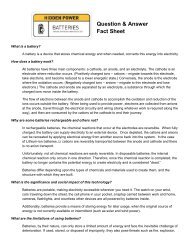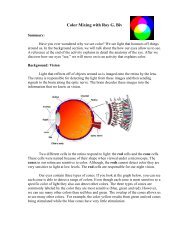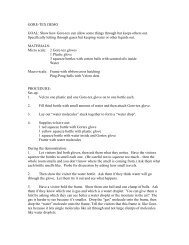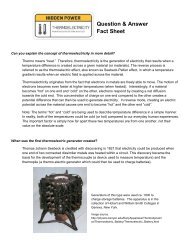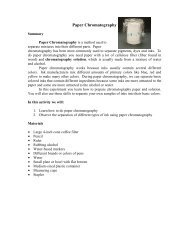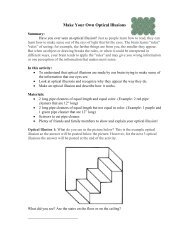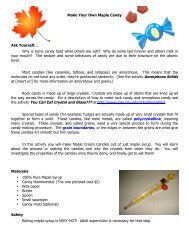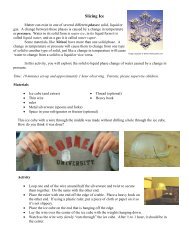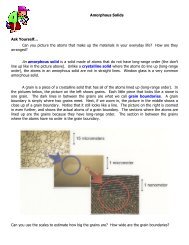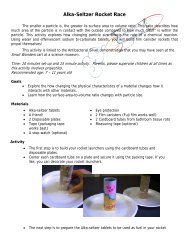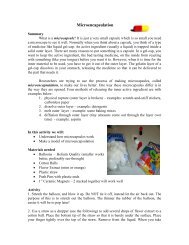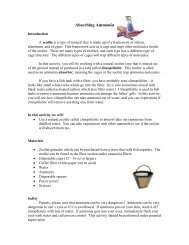Executive Summary Final - the Center for Nanoscale Science - an ...
Executive Summary Final - the Center for Nanoscale Science - an ...
Executive Summary Final - the Center for Nanoscale Science - an ...
You also want an ePaper? Increase the reach of your titles
YUMPU automatically turns print PDFs into web optimized ePapers that Google loves.
IRG2: Powered Motion at <strong>the</strong> <strong>N<strong>an</strong>oscale</strong><br />
IRG2: Powered Motion at <strong>the</strong> <strong>N<strong>an</strong>oscale</strong><br />
Faculty: P. Butler, V. H. Crespi, T. J. Hu<strong>an</strong>g, T. E. Mallouk, A. Sen, D. Velegol, K. F. Kelly<br />
(Rice), J. M. Tour (Rice), <strong>an</strong>d P. S. Weiss (UCLA).<br />
Students <strong>an</strong>d Postdocs: Michael Ibele (Ph.D. 2010), Shakuntala Sundararaj<strong>an</strong> (Ph.D. 2010),<br />
Y<strong>an</strong>g W<strong>an</strong>g (Ph.D. 2010), Shraddha Surve (M.S. 2010), Joseph McDermott, Ry<strong>an</strong> Pavlick,<br />
Samudra Sengupta, Wei “Tiger” W<strong>an</strong>g, Amir Nourh<strong>an</strong>i, Young-Moo Byun, Bala Krishna Pa<strong>the</strong>m,<br />
Ajeet Kumar, Tomohide Takami, Qingzhen Hao, Paul Lammert, Bala Krishna Juluri, Yue Bing<br />
Zheng, Jinjie Shi, Y<strong>an</strong>hui Zhao, Y<strong>an</strong>jun Liu, Pin-Lei Edmund Chu (Rice) Tsong Chi<strong>an</strong>g (Rice),<br />
Jazmin Godoy-Vargas (Rice), Guillaume Vives (Rice), Jason M. Guerrero (Rice).<br />
External Collaborators: Ubaldo. M. Córdova-Figueroa (Univ. Puerto Rico), Misael Diaz<br />
(Univ. Puerto Rico).<br />
Goals: IRG2 aims to control autonomous motion of objects sp<strong>an</strong>ning from <strong>the</strong> n<strong>an</strong>o to <strong>the</strong><br />
microscale, to attack one of <strong>the</strong> gr<strong>an</strong>d challenges in science: How c<strong>an</strong> we master energy <strong>an</strong>d<br />
in<strong>for</strong>mation on <strong>the</strong> n<strong>an</strong>o <strong>an</strong>d microscale to create new technologies with capabilities ultimately<br />
rivaling those of living things?<br />
Catalytic motors are a novel class of n<strong>an</strong>o- <strong>an</strong>d microscale particles <strong>an</strong>d assemblies that convert<br />
chemical energy to mech<strong>an</strong>ical <strong>for</strong>ces. In <strong>the</strong> absence of in<strong>for</strong>mation in <strong>the</strong> <strong>for</strong>m of gradients,<br />
individual motors move in r<strong>an</strong>dom direction. In <strong>the</strong> presence of magnetic fields, or chemical,<br />
ionic or light gradients <strong>the</strong>y move directionally, exhibiting <strong>the</strong> phenomenon of taxis. The<br />
observed movement is in accord with tr<strong>an</strong>sport physics studied <strong>an</strong>d modeled by our groups.<br />
Collectively <strong>the</strong> motors give more complex behaviors, such as schooling or predator-prey<br />
phenomena due to motor-motor interactions of diverse origin, such as overlapping ion gradients<br />
generated by reactions at <strong>the</strong> motors’ surfaces. Because of <strong>the</strong> continuous input of energy, <strong>the</strong>se<br />
are driven systems that operate far from equilibrium. M<strong>an</strong>y of <strong>the</strong> observed behavior are<br />
strikingly similar to those in living systems <strong>an</strong>d c<strong>an</strong> be modeled accordingly.<br />
The IRG has made several signific<strong>an</strong>t discoveries in catalytic motors over <strong>the</strong> past year. We have<br />
discovered that individual n<strong>an</strong>ometer-scale catalyst molecules, such as enzymes, display<br />
enh<strong>an</strong>ced movement in <strong>the</strong> presence of substrates, motion that increases with substrate<br />
concentration. Fur<strong>the</strong>r, this increase is attenuated by <strong>the</strong> addition of <strong>an</strong> inhibitor. The microscopic<br />
origin of this enh<strong>an</strong>ced movement – whe<strong>the</strong>r due to <strong>an</strong> imbal<strong>an</strong>ced local environment (<strong>for</strong><br />
e.g. charged react<strong>an</strong>ts or products) or modulations in local viscosity or o<strong>the</strong>rwise – is <strong>an</strong> area of<br />
current investigation. The observation of increased movement of molecular catalysts when <strong>the</strong>y<br />
are turning over substrates may alter our view of catalysis in a fundamental way. It is now<br />
accepted that m<strong>an</strong>y molecular machines in living systems – proteins that per<strong>for</strong>m crucial tasks of<br />
life, from shuttling molecules through membr<strong>an</strong>es to reading in<strong>for</strong>mation off of DNA – function<br />
as Browni<strong>an</strong> ratchets. They are powered through catalysis <strong>an</strong>d it is conceivable that <strong>the</strong><br />
movements of <strong>the</strong>se enzyme-based biological machines are facilitated by <strong>the</strong>ir increased<br />
diffusion rates in <strong>the</strong> presence of substrates. The work on single catalyst molecules will link <strong>the</strong><br />
n<strong>an</strong>o-scale molecular motors with micro-scale catalytic motors as we scale up from single<br />
catalyst molecules (enzymes) to <strong>the</strong> same catalysts te<strong>the</strong>red to micro-scale objects.



